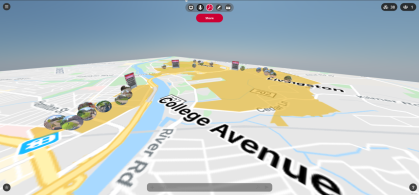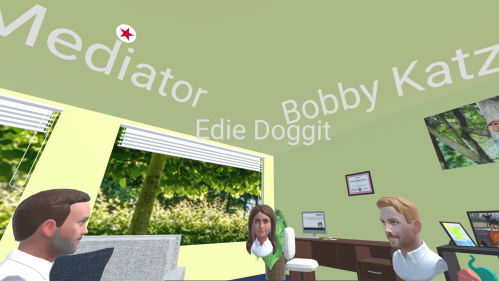As Rutgers gears up for a fall semester of mostly remote learning, the university’s tech innovators are rolling out alternatives to the web conferencing format that has become a hallmark of life in the pandemic.
They have turned to immersive design tools that make it possible for professors to engage with students in a virtual world. It brings some of the characteristics of a classic Choose Your Own Adventure novel: allowing students to make decisions that drive outcomes based on their choices and actions using game technologies and concepts.
“If the world you create looks just like real life, you may have a technical achievement, but you haven’t created the emotional involvement that motivates learners,” says Rick Anderson, director of virtual worlds at Teaching and Learning with Technology (TLT). “When you’re creating a virtual world, the goal is to immerse the person in the challenge in front of them – to make them want to jump in.”
Caroline Petrilla is using the technology to teach a course in civil mediation at Rutgers Law School in Camden to create a compelling way for participants to resolve a theoretical neighborhood dispute virtually.
Students choose an avatar to work through the mediation process using TLT’s Game Research and Immersive Design (GRID). The avatars themselves can be true to life or whimsical, “Lego-like creatures,” Petrilla says. “The one with the panda head is the most popular,” she adds with a laugh.
Working through avatars opens novel opportunities for students to analyze perceptions and emotions in the mediation process, she said.
“Unlike Zoom, or Go To Meeting, it takes appearance out of the equation. It really forces you to realize how much you rely on sensory perception, and how that affects your own emotions and responses,” Petrilla said.
The term "immersive design" describes embedding media with content that allows audiences to actively interact and experience a cause and effect to their actions urging them to explore more.
“The goal of virtual worlds is to create a ‘third space’ that allows students to meet with each other or with faculty in a place that doesn't feel like yet another web meeting. Our goals include opening this to more of the Rutgers community over time and helping students to create their own virtual spaces,” says Anderson.
A New Model for Student Orientation
GRID has applied immersive design to the student orientation process as well.

The Rutgers New Student Orientation and Family Programs team at Rutgers faced a different challenge. How to give students a thorough tour when the campus was closed? And when many students were still in their hometowns, or even stuck abroad?
“We could have just recorded a video, made a slideshow where you just keep clicking ‘Next,’” says assistant director Nehemiah J. Chung. “But GRID took it above and beyond. In just three weeks they created this virtual world where you can ‘fly’ from campus to campus, while orientation leaders point out the different buildings, explain the various resources. During the synchronous part of orientation, students can ask questions through a microphone, chat function and be part of a small group breakout sessions.”
While the virtual tour preserves the feeling of a regular campus orientation, its online format has the advantage of erasing any barriers to participation. “We had students joining us from China, Kenya, all over the world,” says Chung. “Even if they won’t be able to be here in September, they could see what their life is going to look like.”
The students all seem to appreciate the interactive aspect of it, and the “coolness” of the virtual world, Chung relates.
GRID was created as an educational technology innovation center within the TLT at the Division of Continuing Studies (DoCS), which was founded in 1996 to coordinate distance learning at Rutgers as the dawn of the World Wide Web revolutionized opportunities for online delivery.
“We’ve continually expanded our capacity to support faculty and students in online learning for 25 years, so when the pandemic hit we had a team already in place,” said Richard J. Novak, vice president for Continuing Studies and Distance Education. “We created GRID to make innovation more accessible and more affordable.”
Chung found just that. “The collaboration with GRID was key,” says Chung. “They were really open to feedback, and making this meet the students’ needs. They were able to pull it all together in such a limited time.”



